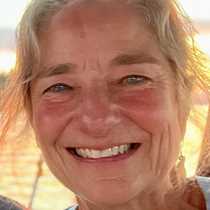Hell’s Canyon & Clearwater River
This morning before breakfast, National Geographic Sea Bird passed through the lock at Lower Granite Dam on the Snake River, and then we disembarked to explore the region. Some of us went via bus to visit sites where Lewis and Clark camped along the Clearwater River. Our guide, Lin, told us legends of the Nez Perce people. And some of us learned a traditional frontier skill: how to start a fire without a match.
Many of us opted to spend the day seeing Hell’s Canyon via jet boat. We saw wonderful rocks towering above the river: parallel columns of basalt rock that curved and bent. Rocky areas were interspersed with tiny, white sandy beaches, and behind there were rolling, dry grassy hills. Sumac trees turning bright red gave splashes of autumn color to the brown and tan landscape. Green water was calm in some places, but in many areas, there were waves and rapids, and the ride was comfortable in the jet boat that moved along quickly over the shallow water. Fishermen were in small boats on the river, catching steelhead. We stopped at Cache Creek, the location of a small old ranch, where apple trees, fig trees, and walnut trees planted decades ago still grow, and today, black bears sometimes wander through to eat the apples. We saw a group of big horn sheep ewes down by the river’s edge. The jet boat pulled in close so we could see petroglyphs on the canyon wall that are believed to be 6,000-9,000 years old. We passed along the borders of Washington, Idaho and Oregon!
Late in the afternoon, our two groups were reunited at the New Perce Interpretive Center near Lewiston, Idaho. We heard personal stories from the Park Ranger, Kevin, who is himself a Nez Perce Indian. The museum houses beautiful artifacts, and many old photographs, and Kevin’s stories helped bring them all to life. As we returned to the ship in Clarkston, Washington, the nearly full moon was bright in the clear sky at dusk.




